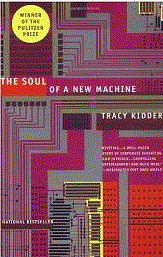Back in my last term at Duke our technology strategy professor, Wes Cohen, assigned us two chapters from The Soul of a New Machine by Tracy Kidder. I'm reading the whole book now that I've got some time. Anyone who has the least interest in how teams work and where technology comes from should read it.
 Kidder embedded himself in a team at the Data General corporation from early 1978 to late 1979 as they struggled to bring a 32-bit minicomputer to life. He describes borderline-Apergers engineers, 14-hour days, building motherboards from scratch, untested technologies, irresponsible schedules, burnout, and success—all around a computer that expressed the state of the art for perhaps six months after it came out. When Kidder wrote the book, in 1980, neither he nor any of the people he wrote about knew that minicomputers had become obsolete as a class already. None of them could see that IBM's toy computer, the PC, was about to make Data General irrelevant.
Kidder embedded himself in a team at the Data General corporation from early 1978 to late 1979 as they struggled to bring a 32-bit minicomputer to life. He describes borderline-Apergers engineers, 14-hour days, building motherboards from scratch, untested technologies, irresponsible schedules, burnout, and success—all around a computer that expressed the state of the art for perhaps six months after it came out. When Kidder wrote the book, in 1980, neither he nor any of the people he wrote about knew that minicomputers had become obsolete as a class already. None of them could see that IBM's toy computer, the PC, was about to make Data General irrelevant.
Kidder describes the team debugging prototype CPUs using oscilloscopes. He explains the near-impossibility of writing microcode—the instructions that tell a physical set of chips what to do and in what order—without using a second computer to write it on. He talks about engineers carrying around punchboard covered in blue and red wires, the red ones representing bug fixes, the blue representing the first attempt. You think it sucks figuring out which class broke the build in a modern C# development environment? Try imagining your joy at discovering that the CPU didn't work because a piece of solder came undone.
I imagine my reaction to this book might be similar to that of a modern nuclear submariner reading a contemporary account of building a state-of-the-art wooden battleship in 1862 (with only a brief mention of the Monitor and Merrimac, because almost no one understood in 1862 what those ships meant to naval combat). There are parts that made me wince, exactly as I winced in the episode of Mad Men when they showed an invitation to a wedding—to be held 22 November 1963.
About two years ago I read Pete Peterson's account of the heyday of WordPerfect Corp., which I also recommend, but for different reasons. Peterson wrote knowing the outcome, and he also had an axe to grind; but "Almost Perfect" still hits me right in the gut as a practicing software developer.
Twenty or thirty years from now, I'll look back and laugh at everything I didn't know in 2011. The Soul of a New Machine is a brilliantly-written monument to getting the job done, and advancing the profession right into a cul-de-sac.